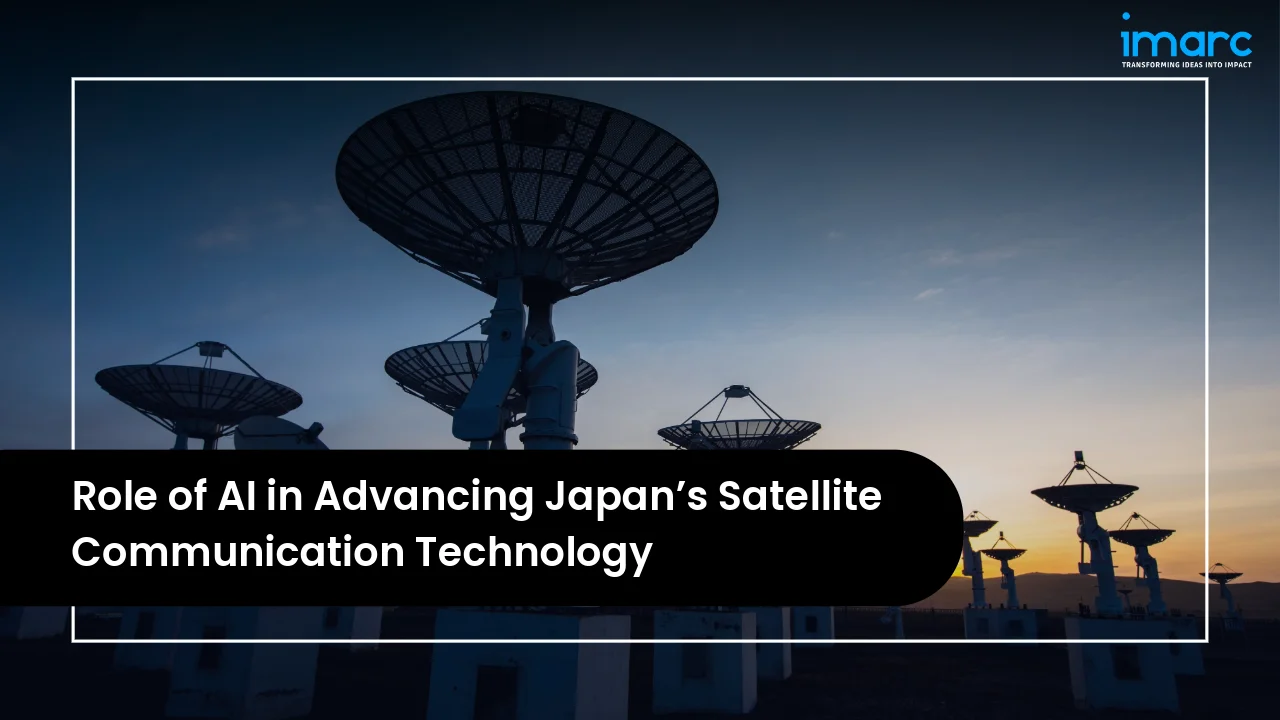Role of AI in Advancing Japan’s Satellite Communication Technology

Overview of Japan’s Satellite Communication Landscape:
Japan, a global leader in technological innovation, is at the forefront of a new digital revolution in its satellite communication sector. As the nation pushes toward a more connected and resilient future, the integration of Artificial Intelligence (AI) is proving to be a critical catalyst. From enhancing network performance to automating complex operations AI is not just an add-on it is a foundational technology reshaping the very fabric of satellite communication. AI is proving to be a critical catalyst for this transformation driving efficiency in network management, enhancing data analytics, and enabling more resilient systems.
Japan’s satellite communication market is characterized by a combination of robust technological capabilities, rising demand for resilient connectivity, and increasing integration with AI-driven solutions. The sector is not limited to traditional broadcast and telecommunication services but also extends to Earth observation, defense, navigation, and emerging small satellite markets. According to the IMARC’s Japan satellite communication report, the market was valued at USD 5.7 Billion in 2024 and is expected to reach USD 17.5 Billion by 2033, exhibiting a CAGR of 13.3% during 2025-2033.

Explore in-depth findings for this market, Request Sample
Current Trends in Satellite Communication in Japan:
- Shift Toward Flexible Architectures: Japan is moving away from traditional satellite systems toward agile and adaptable architectures allowing faster deployment and greater resilience. This shift enables operators to address diverse market demands more effectively and ensures scalability as communication requirements grow in complexity and volume.
- Adoption of Small Satellites and LEO Constellations: The rise of small satellites and low Earth orbit (LEO) constellations is reshaping communication infrastructure. For instance, in February 2025, Japan's SKY Perfect JSAT committed USD 230 Million to Planet for a LEO imagery constellation marking a significant expansion into Earth observation. The deal includes 10 Pelican satellites enhancing access to defense markets and leveraging in-house data analysis capabilities.
- AI-Driven Resource Optimization: Artificial Intelligence is enhancing satellite communication efficiency by optimizing bandwidth, reducing latency, and improving overall signal quality. AI integration ensures reliable and secure connectivity, which is vital for meeting Japan’s growing demand for high-speed communication across industries such as transportation, energy, and national security.
- Industry-Wide Adoption of Satellite Data: Sectors including agriculture, logistics, maritime, and disaster management are increasingly leveraging satellite data. By enabling real-time monitoring, predictive insights, and improved decision-making, satellite communication supports operational efficiency and risk management, contributing to industry-wide digital transformation and competitiveness. For instance, in April 2025, Space Compass Corporation secured a contract with Japan's Ministry of Defense for a "Geostationary Orbit Optical Communication Technology Demonstration" project, aimed at enhancing Space Domain Awareness through optical data relay satellites, crucial for national space security efforts.
Key Opportunities and Challenges in Japan’s Satellite Communication Market:
Opportunities:
- AI-Driven Spectrum Optimization: Leveraging AI for dynamic spectrum allocation offers a path forward. Intelligent algorithms can minimize interference and maximize bandwidth efficiency, ensuring higher-quality communication services. This innovation helps Japan address spectrum scarcity challenges while supporting the growth of next-generation satellite-enabled services.
- Advanced Data Compression: AI-powered data compression technologies are opening new opportunities to enhance communication speed and reduce transmission costs. By handling large volumes of data more efficiently, these solutions enable industries to unlock real-time insights, supporting applications from Earth observation to disaster management.
- Autonomous Satellite Management: The adoption of AI-driven autonomous satellite systems is reducing operational overhead while enhancing precision. By automating navigation, fault correction, and system adjustments, Japan can strengthen reliability, improve efficiency, and reduce reliance on extensive human intervention in satellite operations.
Challenges:
- Spectrum Scarcity: Limited spectrum availability poses a significant challenge, as demand for satellite services continues to rise alongside terrestrial 5G and IoT expansion. This scarcity can lead to interference issues and inefficiencies, making spectrum optimization a top priority for Japan’s satellite communication stakeholders.
- High Capital Expenditure: Building and maintaining advanced satellite systems requires substantial investment. From manufacturing to launch and operations, the costs remain high. These financial barriers can restrict smaller players, while prompting the industry to seek collaborative models and AI-driven cost efficiencies to sustain competitiveness.
- Regulatory Constraints: Japan’s satellite communication sector must navigate evolving regulatory frameworks concerning spectrum allocation, data sharing, and international compliance. These complexities often slow adoption and innovation, making regulatory alignment a crucial factor in enabling the sector’s expansion while ensuring secure and responsible operations.
How AI is Enhancing Satellite Network Performance:
AI technologies are proving instrumental in driving efficiency and resilience in satellite communication. By automating processes and introducing predictive intelligence, AI reduces downtime, improves signal quality, and maximizes resource utilization.
AI-Driven Signal Processing and Optimization
Signal processing lies at the core of satellite communication performance. AI-driven algorithms can analyze massive volumes of real-time signal data to reduce interference, minimize latency, and optimize bandwidth allocation. In Japan, where demand for high-capacity communication services is increasing, AI-based optimization ensures superior service quality for industries dependent on uninterrupted connectivity. Such advancements are critical in enabling new applications, from autonomous vehicle navigation to seamless IoT device integration.
Predictive Maintenance and Fault Detection in the Japan Satellite Communication Market
Traditional satellite maintenance is resource-intensive and reactive. AI transforms this approach by enabling predictive maintenance that identifies anomalies before they evolve into failures. By continuously monitoring telemetry data, AI systems can detect irregular patterns, predict potential malfunctions, and recommend corrective measures. For Japan’s satellite operators, this reduces operational costs and minimizes service disruptions, a critical factor in sectors such as defense, aerospace, and national security where reliability is paramount. For instance, in May 2024, JAXA, JR-West, and SKY Perfect JSAT announced their partnership to apply AI-based failure prediction technology, aiming to enhance satellite operations through advanced anomaly detection and data analysis, ensuring improved efficiency and reliability in space.
AI in Satellite Data Management and Analytics:
The growing volume of satellite-generated data demands intelligent management systems capable of extracting actionable insights. AI offers solutions by enabling advanced analytics, automated categorization, and real-time decision support.
Big Data Processing from Satellite Feeds in the Japan Satellite-Based Earth Observation Market
Earth observation satellites produce vast datasets covering climate monitoring, land use, maritime navigation, and urban planning. AI-powered analytics streamline the processing of this big data, converting raw feeds into meaningful intelligence. In Japan, applications range from precision agriculture to environmental monitoring, where AI enhances accuracy and supports timely interventions. Such capabilities not only serve domestic priorities but also strengthen Japan’s role in providing regional data solutions across Asia-Pacific.
Real-Time Analytics for Improved Decision Making
AI-driven real-time analytics enables stakeholders to make faster, data-backed decisions. Whether for monitoring natural disasters, managing supply chains, or optimizing logistics, AI allows satellite data to be processed and interpreted instantly. For Japanese businesses, this translates into enhanced agility and operational efficiency. In contexts such as defense or disaster management, the ability to act on insights within minutes rather than hours is invaluable.
AI-Powered Satellite Operations and Automation:
Automation, powered by AI, is transforming how satellites are managed, operated, and maintained. This shift reduces human intervention, enhances accuracy, and optimizes resource allocation.
Autonomous Satellite Control Systems
AI enables satellites to operate with greater autonomy by automating navigation, resource allocation, and fault correction. In Japan, this capability is particularly relevant to the growing small satellite and LEO constellation markets, where managing multiple satellites simultaneously is complex. Autonomous systems reduce operational overhead while ensuring consistency and reliability.
AI for Efficient Spectrum Management
Spectrum scarcity is a pressing challenge in satellite communication. AI offers solutions by enabling dynamic spectrum allocation, minimizing interference, and optimizing utilization across multiple users. For Japan, where demand for spectrum is intensifying due to expanding 5G networks and IoT applications, AI-driven spectrum management ensures sustainable growth while supporting the seamless integration of satellite and terrestrial networks.
Applications of AI-Enhanced Satellite Communication in Japan:
The practical applications of AI-enabled satellite systems are extensive, driving value across multiple industries and addressing national priorities.
Disaster Management and Emergency Response
Japan, being prone to natural disasters such as earthquakes, tsunamis, and typhoons, requires resilient communication systems for disaster management. AI-enhanced satellite communication supports rapid damage assessment, real-time monitoring, and efficient resource deployment during emergencies. Automated data analytics from Earth observation satellites enable authorities to predict risks, coordinate responses, and allocate resources effectively, ensuring faster recovery and minimizing human and economic losses. For instance, in May 2025, Mitsubishi Electric, Fujitsu, SDS, and NIED partnered to develop Japan's Disaster Charter, a satellite-based system aimed at enhancing disaster response. Scheduled for demonstration by 2026, it focuses on rapid data delivery and automated satellite tasking for effective emergency management.
Connectivity Solutions for Remote and Rural Areas via Japan Small Satellite Market
Despite Japan’s advanced urban connectivity, rural and remote areas continue to face challenges in accessing reliable communication. AI-powered small satellite constellations offer cost-efficient solutions to bridge this digital divide. By optimizing bandwidth allocation and reducing latency, AI ensures consistent, high-quality connectivity for underserved regions. This advancement not only supports rural development but also creates new opportunities for digital businesses and e-learning platforms in Japan.
Challenges in Integrating AI with Satellite Communication:
While AI presents immense benefits, its integration with satellite communication is not without hurdles. Addressing these challenges is crucial for realizing long-term success.
Data Security and Privacy Concerns
The increasing use of AI to process sensitive satellite data raises concerns regarding security and privacy. In applications, such as defense, intelligence, and critical infrastructure, protecting data from cyber threats is paramount. Japan must strengthen encryption protocols, invest in secure data-sharing frameworks, and establish regulatory safeguards to build trust and ensure compliance.
Technical and Regulatory Barriers
The integration of AI requires significant technical expertise, investment in infrastructure, and alignment with global standards. Regulatory frameworks governing spectrum use, data sharing, and AI applications are still evolving, which can slow adoption. For Japan, navigating these barriers will require close collaboration between government agencies, industry leaders, and international partners to harmonize policies and promote innovation.
Future Outlook: AI and the Evolution of Satellite Communication in Japan
The fusion of AI with satellite communication is expected to accelerate further, ushering in new innovations and business models that will redefine the industry.
Emerging Technologies and Innovations
AI is set to work in tandem with technologies, such as quantum communication, blockchain, and advanced sensors, to create more secure and efficient satellite systems. Japan’s strong research ecosystem positions it to pioneer these advancements, potentially setting global benchmarks. The development of AI-driven ground stations, adaptive antennas, and hybrid space-terrestrial communication systems will further strengthen Japan’s leadership in this domain.
The Path Toward 6G and Beyond
As the global race toward 6G intensifies, satellites will play an integral role in achieving ultra-fast, ubiquitous connectivity. AI will be central to enabling this vision by optimizing spectrum use, managing complex satellite-terrestrial integration, and ensuring low-latency services. For Japan, aligning AI-driven satellite capabilities with its broader 6G roadmap will enhance domestic communication networks and also reinforce its role as a global technology leader.
How IMARC Group is Driving Innovation in Japan’s Satellite Communication Market:
IMARC Group equips stakeholders in Japan’s satellite communication industry with strategic insights that address the growing role of AI and advanced technologies. Our services enable businesses to identify opportunities, mitigate risks, and stay competitive in this rapidly evolving sector through:
- Market Insights: We track key trends such as the transition toward flexible architectures, adoption of small satellites and LEO constellations, and AI-driven optimization. Our research highlights applications across industries including agriculture, logistics, defense, and disaster management, providing clients with clear perspectives on market shifts.
- Strategic Forecasting: We provide forward-looking intelligence on advancements in predictive maintenance, autonomous satellite systems, and AI-enabled spectrum management. These insights help organizations anticipate disruptions, align investment strategies, and prepare for the next phase of industry transformation.
- Competitive Intelligence: Our analysis monitors developments in satellite automation, advanced data processing, and real-time analytics. We assess how leading players are embedding AI into operations to enhance connectivity, strengthen disaster response, and improve decision-making across multiple sectors.
- Policy and Regulatory Analysis: We examine evolving frameworks around spectrum use, AI adoption, and cross-border compliance. This helps clients adapt to regulatory changes, safeguard sensitive data, and align strategies with Japan’s digital transformation agenda.
- Tailored Consulting Solutions: From risk management and infrastructure optimization to market entry strategies, we design consulting services customized to organizational needs. Our solutions ensure enterprises remain agile, competitive, and ready to harness future innovations in satellite communication.
With the market growing at a significant pace, IMARC Group continues to be a trustworthy ally, providing essential insights, driving innovation, and informing strategic decisions to fuel the growth and shape the future of cyber risk management. For detailed insights, data-driven forecasts, and strategic advice, see the complete report on the here: https://www.imarcgroup.com/japan-satellite-communication-market
Our Clients
Contact Us
Have a question or need assistance?
Please complete the form with your inquiry or reach out to us at
Phone Number
+91-120-433-0800+1-201-971-6302
+44-753-714-6104
.webp)










